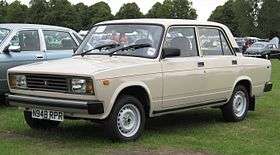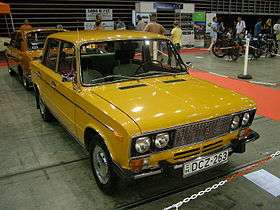Lada
Lada (Cyrillic: Лада, recently stylized as LADA) is a brand of cars manufactured by AvtoVAZ (originally VAZ), a Russian company owned by the French Groupe Renault.[1] The first cars manufactured by AvtoVAZ, with technical assistance from Fiat, were marketed under the Zhiguli brand, allegedly chosen after it was suggested by the designer, A. M. Cherny.[2] When the cars began to be exported on foreign markets, the Zhiguli brand was found to be inappropriate, as it was hard to pronounce for non-Russian speakers, and it was said to resemble the word gigolo too closely.[2]
 | |
| Owner | AvtoVAZ |
|---|---|
| Country | Russia |
| Website | lada |
The Lada brand appeared in 1973, and it has since become the main brand for AvtoVAZ vehicles.[3] The name Lada is derived from a type of small boat in Slavic language (lad'ya), symbolized by the car's logo. The brand has a long history in Russia, and it is well known in post-Soviet countries; today Lada vehicles are positioned as affordable, and as offering good value for money.[4]
The keys to its success were said to be its competitive price, reliability, simple DIY-friendly mechanics and simple functionality. The car was built under license in several other countries. The competitive pricing and ease of service made Ladas popular as police cars, taxis and a range of public service and civil defense vehicles in many parts of Europe, Africa, and the Caribbean.
History


The automaker AvtoVAZ was formed from a collaboration between Fiat and the Soviet Vneshtorg (Department of Foreign Trade), and based in the city of Tolyatti on the Volga river. Both sides discussed the proposal in Moscow, where Gianni Agnelli, the owner and nephew of the founder of Fiat, and Vittorio Valletta, the president of the company, had arrived from Italy. The first preliminary agreement was signed on 1 July 1965. On 4 May 1966, the Soviet minister of automotive industry Alexander Tarasov and Vittorio Valletta put their signatures on a protocol on the scientific and technical cooperation between Fiat and the Soviet ministry. Eventually, a general agreement between the two sides was signed in Moscow on 15 August 1966.[5]
The company began producing the VAZ-2101 in 1970, which was a more rugged version of the Fiat 124 sedan. The car was given heavier steel body panels and strengthened components, which improved reliability on the bumpy roads and in the harsh winters of the Soviet Union.[6][7] In Fiat's documents the prototype of the car was named Fiat-124R, where 'R' stood for Russia.
Since the original Fiat engine did not have any space for modernization, which was considered as unacceptable by AvtoVAZ, it was replaced with a newer overhead camshaft motor. The car was equipped with rugged drum brakes, as the latter proved to be more reliable on poor roads, and more reliable and up-to-date frontal and rear suspensions, along with increased ground clearance, modernized transmission, recessed door handles. The work on the new car was conducted by joint groups of NAMI and Fiat engineers, who worked together in Turin and Tolyatti. By the spring of 1970, AvtoVAZ had formed its own team of experienced designers and engineers and worked independently.[5]
The VAZ-2101 was sold under the brand "Zhiguli" in the Soviet Union, and branded as "Lada" for export. Due to the scarcity of auto repair shops in the Soviet Union, Ladas were designed to be easily maintained by owners.[8] The rugged Lada was popular in Europe, Canada and South America for customers looking for more affordable alternatives to local brands, and sales of the new cars were extremely successful, reaching as far as New Zealand.[9] In the West, their construction was frequently described as cheap and that inspired jokes at the car's expense;[8][10][11] nonetheless, Lada "gained a reputation as a maker of solid, unpretentious and reliable cars for motorists who wanted to drive on a budget."[9]
Models
- Granta sedan
- Granta Drive Active
- Granta liftback
- Granta hatchback
- Granta SW
- Granta Cross
- Vesta sedan
- Vesta Cross
- Vesta SW
- Vesta SW Cross
- Vesta CNG
- Vesta Sport
- XRAY
- XRAY
- XRAY Cross
- Largus Universal
- Largus Universal CNG
- Largus Cross
- Largus Cross CNG
- Largus Wagon
- Largus Wagon CNG
- Lada Niva 4x4
- 4x4 3 door
- 4x4 Urban
- 4x4 5 door
- 4x4 Urban 5 door
- 4x4 BRONTO
See also
- Automobile model numbering system in USSR and Russia
- List of AvtoVAZ vehicles
- AvtoVAZ vehicles in international markets
References
- "BRIEF-Renault now holds over 50 pct of Alliance Rostec Auto BV". Ward's. 6 January 2017. Retrieved 20 January 2018.
- "Происхождение названия "Жигули"". history.vaz.ru. Retrieved 14 December 2017.
- "40 лет назад автомобилю ВАЗ-2101 было присвоено название "Жигули"". РИА Новости (in Russian). 7 September 2010. Retrieved 15 December 2017.
- ""АвтоВАЗ" начнет производство LADA Xcode в течение пяти лет". Vedomosti. 28 August 2016. Retrieved 15 December 2017.
- Ред. Маслов, Г.В.; Мирзоев, Г.К.; Котляров, В.А. Высокой мысли пламень. Управление главного конструктора АВТОВАЗ. Тольятти: АВТОВАЗ. Часть первая. 2000 (Official chronicle by AvtoVAZ with memoirs of its engineers) (in Russian)
- Leaman, Michael R. (2002). "Riding the Survivors of the Soviet Union". In Wollen, Peter; Kerr, Joe (eds.). Autopia: Cars and Culture. Reaktion Books. pp. 164–5. ISBN 978-1-86-189132-7.
- Parissien, Steven (2014). The Life of the Automobile: The Complete History of the Motor Car. Thomas Dunne Books. pp. 248–9. ISBN 978-1-25-004063-3.
- Hamilton, Peter (2002). "The Lada: A Cultural Icon". In Wollen, Peter; Kerr, Joe (eds.). Autopia: Cars and Culture. Reaktion Books. pp. 191–8. ISBN 978-1-86-189132-7.
- Lada // Andy Thompson. Cars of the Soviet Union, Haynes Publishing, 2008.
- Lohr, Steve (10 August 1989). "A Lada in Perestroika's Vanguard". The New York Times.
- Roberts, Andrew (23 January 2012). "Lada has the last laugh". The Daily Telegraph. London, UK.
- http://info.avtovaz.ru/press-releases/117703.html Niva возвращается в семью LADA! (EN:Niva returns to the Lada family}